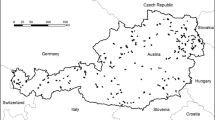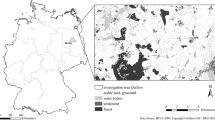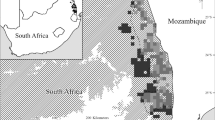Abstract
Birds are important components of biodiversity conservation since they are capable of indicating changes in the general status of wildlife and of the countryside. The Pan-European Common Bird Monitoring Scheme (PECBM) has been launched by the BirdLife Partnership in Europe, where the European Bird Census Council has been collecting data from 20 independent breeding bird survey programs across Europe over the last 25 years. These data show dramatic declines in European farmland birds. We suggest that seasonal characteristics of vegetation cover derived from high temporal resolution remote sensing images could facilitate the monitoring the suitability of farmland bird habitats, and that these indicators may be a better choice for monitoring than climate data. We used redundancy analysis to link the PECBM data of the estimated number of farmland birds in Europe to a set of phenological and climatic indicators and to the biogeographic regions of Europe. Variance partitioning was used to account for the variation explained by the phenological and climate variables and by the area of the environmental strata individually, to define the pure effect of the variables, and to extract the total explained variance. The analysis revealed high statistical significance (p < 0.001) of the correlations between species and environment. Phenological indices explained 38% of the variance in community composition of the 23 farmland bird species, whereas climate explained 30% of the variance. After partitioning the other variables as covariables, the pure effect of phenology, climate, and environmental strata were 16%, 8%, and 16%, respectively. Based on the probability results, we suggest that phenological indicators derived from remote sensing may supply better indicators for continental scale biodiversity studies than climate only. In addition, these indicators are cost and time effective, are on continuous scale, and are readily repeatable on a large spatial coverage while supplying standardized results.





Similar content being viewed by others
References
Anderson, M. J., & Gribble, N. A. (1998). Partitioning the variation among spatial, temporal and environmental components in a multivariate data set. Australian Journal of Ecology, 23, 158–167.
Bailey, S. A., et al. (2004). Primary productivity and species richness: relationships among functional guilds, residency groups and vagility classes at multiple spatial scales. Ecography, 27, 207–217.
BirdLife International (2007). Wellbrook Court Girton Road, Cambridge CB3 0NA, United Kingdom. http://www.birdlife.org.
Blanchet, F. G., Legendre, P., & Borcard, D. (2008). Forward selection of explanatory variables. Ecology, 89, 2623–2632.
Boelman, N. T., Stieglitz, M., Rueth, H. M., Sommerkorn, M., Griffin, K. L., Shaver, G. R., et al. (2003). Response of NDVI, biomass, and ecosystem gas exchange to long-term warming and fertilization in wet sedge tundra. Oecologia, 135, 414–421.
Borcard, D., & Legendre, P. (1994). Environmental control and spatial structure in ecological communities: an example using Oribatid mites (Acari, Oribatei). Environmental and Ecological Statistics, 1, 37–61.
Borcard, D., & Legendre, P. (2002). All-scale spatial analysis of ecological data by means of principal coordinates of neighborhood matrices. Ecological Modelling, 153, 51–68.
Borcard, D., Legendre, P., & Drapeau, P. (1992). Partialling out the spatial component of ecological variation. Ecology, 73(3), 1045–1055.
Borcard, D., Legendre, P., Avois-Jacquet, C., & Tuomisto, H. (2004). Dissecting the spatial structure of ecological data at multiple scales. Ecology, 85, 1826–1832.
Chamberlain, D. E., Fuller, R. J., Bunce, R. G. H., Duckworth, J. C., & Shrubb, M. (2000). Changes in the abundance of farmland birds in relation to the timing of agricultural intensification in England and Wales. Journal of Applied Ecology, 2000(37), 771–788.
Chatterjee, S., & Price, B. (1977). Regression analysis by example. New York: Wiley.
de Beurs, K. M., & Henebry, G. M. (2010). Spatio-temporal statistical methods for modelling land surface phenlogy. In I. L. Hudson & M. R. Keatley (Eds.), Phenological research: methods for environmental and climate change analysis (pp. 177–208). Dordrecht: Springer.
Derksen, S., & Keselman, H. J. (1992). Backward, forward and stepwise automated subset selection algorithms: frequency of obtaining authentic and noise variables. The British Journal of Mathematical and Statistical Psychology, 45, 262–282.
Easterling, D. R., Horton, B., Jones, P. D., Peterson, T. C., Karl, T. R., Parker, D. E., et al. (1997). Maximum and minimum temperature trends for the globe. Science, 277, 364–367.
Evans, K. L., Warren, P. H., & Gaston, K. J. (2005a). Species–energy relationships at the macroecological scale: a review of the mechanisms. Bilogical Reviews, 80, 1–25.
Evans, K. L., Greenwood, J. J. D., & Gaston, K. (2005b). Dissecting the species-energy relationship. Proceeding of the Royal society B, 272, 2155–2163.
Evans, K. L., James, N. A., & Gaston, K. J. (2006). Abundance, species richness and energy availability in the North American avifauna. Global Ecology and Biogeography, 15, 372–385.
Freedman, L. S., Pee, D., & Midthune, D. N. (1992). The problem of underestimating the residual error variance in forward stepwise regression. Statistician, 41, 405–412.
Furness, R. W., & Greenwood, J. J. D. (1993). Birds as monitors of environmental change. London: Chapman & Hall.
Gates, S., & Donald, P. F. (2000). Local extinction of British farmland birds and the prediction of further loss. Journal of Applied Ecology, 37, 806–820.
Gilbert, B., & Bennett, J. R. (2010). Partitioning variation in ecological communities: do the numbers add up? Journal of Applied Ecology, 47, 1071–1082.
Goward, S. N., Dye, D., Kerber, A., & Kalb, V. (1987). Comparison of North and South American biomes from AVHRR observations. GeoCarto International, 1, 27–39.
Gregory, R. D., van Strien, A., Vorisek, P., Meyling, A. W. G., Noble, D. G., Foppen, R. P. B., et al. (2005). Developing indicators for European birds. Phil. Trans. R. Soc. B, 360, 269–288.
Hagemeijer, E. J. M., & Blair, M. J. (Eds.). (1997). The EBCC Atlas of European Breeding Birds: their distribution and abundance. London: T & A.D. Poyser.
Hawkins, B. A. (2004). Summer vegetation, deglaciation and the anomalous bird diversity gradient in eastern North America. Global Ecology and Biogeography, 13, 321–325.
Hawkins, B. A., Field, R., Cornwell, H. V., Currie, D. J., Guegan, J.-F., Kaufman, D. M., et al. (2003). Energy, water and broad-scale geographic patterns of species richness. Ecology, 84, 3105–3117.
Holm, A. M. C. R., Cridland, S. W., & Roderick, M. L. (2003). The use of time-integrated NOAA NDVI data and rainfall to assess landscape degradation in the arid shrubland of Western Australia. Remote Sensing of Environment, 85, 145–158.
Hudson, I. L. (2010). Interdisciplinary approaches: towards new statistical methods for phenological studies. Climatic Change, 100, 143–171.
Hurlbert, A. H., & Haskell, J. P. (2003). The effect of energy and seasonality on avian species richness and community composition. The American Naturalist, 161, 83–97.
Jeanneret, F., & Rutishauser, T. (2010). Phenology for topoclimatological surveys and large-scale mapping. In I. L. Hudson & M. R. Keatley (Eds.), Phenological research: methods for environmental and climate change analysis (pp. 159–175). Dordrecht: Springer.
Jeanneret, F., & Rutishauser, T. (2010). Seasonality as a core business of phenology. In I. L. Hudson & M. R. Keatley (Eds.), Phenological research: methods for environmental and climate change analysis (pp. 63–74). Dordrecht: Springer.
Jongman, R. H. G., Ter Braak, C. J. F., & Van Tongeren, O. F. R. (1995). Data analysis in community and landscape ecology. New York: Cambridge University Press.
Kaspari, M., Ward, P. S., & Yuan, M. (2004). Energy gradients and the geographic distribution of local ant diversity. Oecologia, 140, 407–413.
Kernan, M. R., & Helliwell, R. C. (2001). Partitioning the variation within the acid neutralizing capacity of surface waters in Scotland in relation to land cover, soil and atmospheric depositional factors. The Science of the Total Environment, 265, 39–49.
Kerr, J. T., & Ostrovosky, M. (2003). From space to species: ecological applications for remote sensing. Trends in Ecology & Evolution, 18, 299–305.
Kerr, J. T., & Packer, L. (1996). Habitat heterogeneity as a determinant of mammal species richness in high-energy regions. Nature, 385, 252–254.
Legendre, P. (1993). Spatial autocorrelation: trouble or new paradigm? Ecology, 74, 1659–1673.
Legendre, P., & Fortin, M.-J. (1989). Spatial pattern and ecological analysis. Vegetatio, 80, 107–138.
Legendre, P., & Gallagher, E. D. (2001). Ecologically meaningful transformations for ordination of species data. Oecologia, 129, 271–280.
Legendre, P., & Legendre, L. (1998). Numerical ecology, second English ed (p. 853). Amsterdam: Elsevier Science BV.
Lennon, J. J., Greenwood, J. J. D., & Turner, J. R. G. (2000). Bird diversity and environmental gradients in Britain: a test of the species–energy hypothesis. The Journal of Animal Ecology, 69, 581–598.
Lepš, J., & Šmilauer, P. (2003). Multivariate analysis of ecological data using CANOCO. Cambridge: Cambridge University Press. pp. 269.
Marra, P. P., Francis, C. M., Mulvihill, R. S., & Moore, F. R. (2005). The influence of climate on the timing and rate of spring bird migration. Oecologia, 142, 307–315.
Metzger, M. J., Bunce, R. G. H., Jongman, R. H. G., Mücher, C. A., & Watkins, J. W. (2005). A climatic stratification of the environment of Europe. Global Ecology and Biogeography, 14, 549–563.
Mitchell, T.D., Carter, T.R., Jones, P.D., Hulme, M., New M. (2004). A comprehensive set of high-resolution grids of monthly climate for Europe and the globe: the observed record (1901–2000) and 16 scenarios (2001–2100). Tyndall Centre Working Paper no. 55. Tyndall Centre for Climate Change Research, University of East Anglia, Norwich, UK.
Montgomery, D. C., & Peck, E. A. (1982). Introduction to linear regression analysis. New York: Wiley. 504.
Murphy, M. T. (2003). Avian population trends within the evolving agricultural landscapes of eastern and central United States. The Auk, 120, 20–34.
Oindo, B. O., & Skidmore, A. K. (2002). Interannual variability of NDVI and species richness in Kenya. International Journal of Remote Sensing, 23(2), 285–298.
Pautasso, M., & Gaston, K. J. (2005). Resources and global avian assemblage structure in forests. Ecology Letters, 8, 282–289.
Peres-Neto, P. R., Legendre, P., Dray, S., & Borcard, D. (2006). Variation partitioning of species data matrices: estimation and comparison of fractions. Ecology, 87, 2614–2625.
Phillips, L. B., Hansen, A. J., & Flather, C. H. (2008). Evaluating the species energy relationship with the newest measures of ecosystem energy: NDVI versus MODIS primary production. Remote Sensing of Environment, 112, 3538–3549.
Pimm, S. L., & Brown, J. H. (2004). Domains of diversity. Science, 304, 831–833.
Reed, B. C., Brown, J. F., VanderZee, D., Loveland, T. R., Merchant, J. W., & Ohlen, D. O. (1994). Measuring phenological variability from satellite imagery. Journal of Vegetation Science, 5, 703–714.
Schwartz, M. D. (1998). Green Wave phenology. Nature, 394, 839–840.
Siriwardena, G. M., Baillie, S. R., Buckland, S. T., Fewster, R. M., Marchant, J. H., & Wilson, J. D. (1998). Trends in the abundance of farmland birds: a quantitative comparison of smoothed Common Birds Census indices. Journal of Applied Ecology, 35, 24–43.
Ter Braak, C. F. J. (1987). CANOCO—a FORTRAN Program for CANOnical Community Ordination by [partial] [detrended] [canonical] correspondence analysis, principal components analysis and redundancy analysis (version 3.1). Agriculture Mathematics Group: Wageningen.
ter Braak, C. J. F. (1994). Canonical community ordination. Part I: basic theory and linear methods. Ecoscience, 1, 127–140.
Thorup, K., Tottrup, A. P., & Rahbek, C. (2007). Patterns of phenological changes in migratory birds. Oecologia, 151, 697–703.
Totland, Ǿ., & Nylehn, J. (1998). Assessment of the effect of environmental change on the performance and density of Bistoria Vivipara: the use of multivariate analysis and experimental manipulation. Journal of Ecology, 86, 989–998.
Tucker, G. M., & Heath, M. F. (1994). Birds in Europe. Their conservation status. Birdlife conservation series no. 3. Cambridge: Birdlife International.
Wright, D. H. (1983). Species-energy theory, an extension of species-area theory. Oikos, 41, 496–506.
Acknowledgement
The authors express their great thanks to Wolfgang Mehl from EC JRC, Ispra for his comments and programming skills. Furthermore, we are most grateful to the EBCC, and for Richard Gregory for providing the data and allowing us to use it.
Author information
Authors and Affiliations
Corresponding author
Rights and permissions
About this article
Cite this article
Ivits, E., Buchanan, G., Olsvig-Whittaker, L. et al. European Farmland Bird Distribution Explained by Remotely Sensed Phenological Indices. Environ Model Assess 16, 385–399 (2011). https://doi.org/10.1007/s10666-011-9251-9
Received:
Accepted:
Published:
Issue Date:
DOI: https://doi.org/10.1007/s10666-011-9251-9




